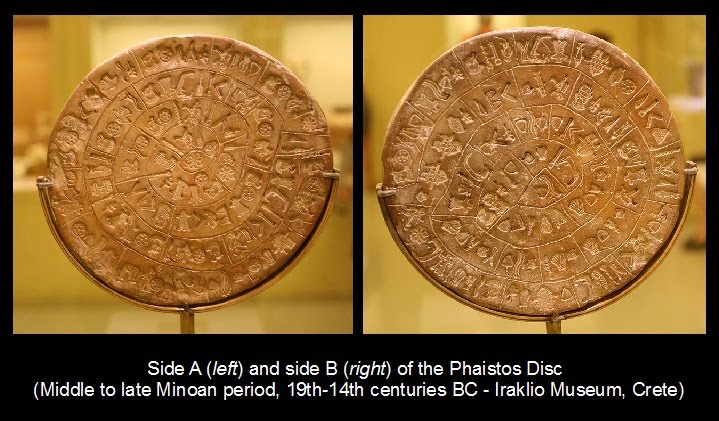Phaistos Disk
Definition
The Phaistos disk is a fired clay disk, probably of Minoan origin, measuring some 16cm in diameter and impressed on both sides with 242 symbols set in a spiral arrangement. As yet, this unique archaeological find remains an undeciphered enigma.
Discovered in 1908 in the ‘Old Palace’ (1900 to 1700 BCE) of Minoan Phaistos on Crete , little is known for certain about the disk and its origin, manufacture, purpose and meaning are much debated amongst scholars.
The disk is now generally accepted as Cretan in origin and therefore is probably a representation of the Minoan language in use during the period at which scholars date the disk - from 1850 to 1550 BCE. Arguments that it is of native Minoan manufacture include the presence of popular Minoan artistic motifs such as dolphins, cattle, lilies and crocuses. The fact that the symbols are arranged in a spiral is also given as evidence supporting the Minoan (or at least Aegean ) origin.
Measuring from 15.8 to 16.5cm in diameter and 1.6 to 2.1cm in thickness, the variation in size suggests that it was handmade. The 243 symbols are set on a spiral pattern of hand drawn lines and are separated into groups of between 2 and 7 symbols by vertical lines. The symbols seem to be oriented to the right, for example, a walking man and a face either walk or look to the right. This would suggest the symbols should be read from the centre of the disk outwards. Some symbols are represented vertically - a fish and a boat - and again point to the outer edge of the disk. Although the disk is unique, similar, but not identical symbols have been found on a bronze axe found at Arkalokhori in central Crete and the Mohican head symbol is similar to three clay statues found in the cave shrine of Traostalos in Crete (in use 1700-1600 BCE).
The 45 different symbols represented on the disk seem to have been individually stamped (although some symbols of the same type seem to have been made with different stamps) and the disk then fired. Also, some symbols show evidence of having been erased and re-stamped either with the same symbol or a different one. Unfortunately, no stamps have as yet been found but their use in the manufacture of the disk would suggest other disks were, or were intended to be, made.
In addition to the symbols on the disk, there are also dashes and dotted bars impressed in the clay. The dashes or slanted lines seem hand-drawn and always occur under the symbol to the left of the symbols within a group as demarcated by the vertical lines. However, the dashes are not present in every group. Suggestions as to their significance include markers as the start of the word, pre-fixes or suffixes, extra vowels or consonants, verse and stanza dividers, or punctuation marks. Finally, as the lines are irregular in execution and not as carefully marked as the other symbols, it has also been suggested that they are simply accidental marks made during the manufacture process. The dotted lines occur near the outer edge of the spiral on both sides. Suggestions as to their significance include markers of the beginning or end of the text or as chapter markers linking the disk to other disks which together form a continuous text.
The significance of the symbols is hotly debated amongst scholars both in terms of what each symbol literally represents and their linguistic meaning. What can be said is that all known writing systems presently fit into one of three categories: pictographies, syllabaries, and alphabets . It has been suggested that the number of different symbols on the disk are too few to be part of a purely pictographic system and too many to be an alphabet. This leaves syllabary as the most likely option - each symbol is a syllable and each group of symbols is a word. Indeed this is the system of the later Mycenaean Linear B. However, in such systems, one would expect to find a reasonably even distribution of symbols within a given text and this is not the case with the two sides of the disk each displaying an uneven distribution of certain symbols. In addition, interpreting the text as a syllabary would rather surprisingly provide no one-syllable words and only 10% would have two syllables. For these reasons, it has been suggested that some of the symbols represent syllables while others represent whole words i.e.: they are pure pictographs.
Without any concrete evidence whatsoever, various theories as to the significance of the text on the disk include a hymn to the earth goddess, a court list, an index of religious centres, a letter of greeting, a fertility ritual, and even musical notes. However, unless other disks are found which would give linguists a wider range of text to study or archaeologists discover an equivalent of a Rosetta stone, we must face the likelihood that the Phaistos disk will remain a tantalising mystery which hints at, yet does not reveal, a language that has been lost to us.
Written by Mark Cartwright , published on 28 June 2012 under the following license: Creative Commons: Attribution-NonCommercial-ShareAlike . This license lets others remix, tweak, and build upon this content non-commercially, as long as they credit the author and license their new creations under the identical terms.
